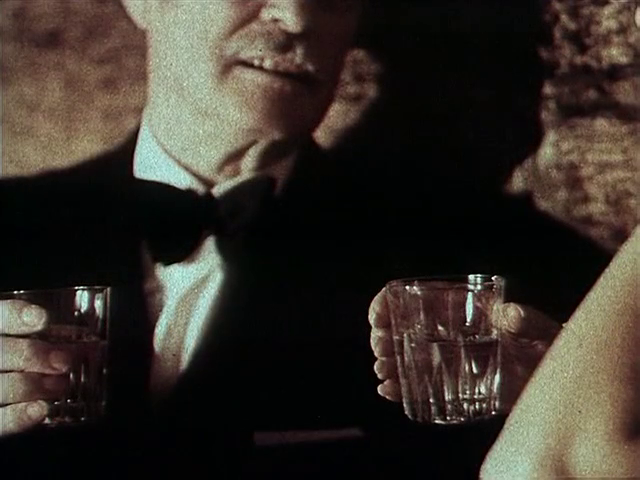viewColloque de chiens (1977)
Monique (Silke Humel, R) spending Christmas Eve in a bar, looking for a way out. She's speaking to an elderly man in an expensive tuxedo. Is this it? DP: Denis Lenoir; still photographer Patrice Morere.

December 24: the night before Christmas (Christmas Eve)
Colloque de chiens (Raúl Ruiz, 1977)
“Nobody knows why Monique, the cold and dry voiced whore, bears in her eyes the sadness and tiredness of her past.”
Filmed during an actors' strike, Raúl Ruiz's Colloque de chiens consists for the most part of still photographs with mixed in stolen moving footage of unsuspecting bystanders and stray dogs. Told in fotonovela format, we follow the pitiful account of Monique, who as a young girl, learns that her mother is not who she thinks she is. Rejected, she throws herself into a life of vice until she meets Henri, a handsome young television repairman. Together they buy a small café, and are happy for once. But the cyclical nature of life determines her faith.
Raúl Ruiz's work is, like Henri's modus operandi, determined by maps and patterns. Even in the short comically melodramatic breathe of Colloque de chiens, the map has been laid out for Ruiz's later, much more complex narrative.
Colloque opens in a barren landscape. There are the skeletal towers of a nearby city, and the endless barks of abandoned dogs. Obscured by tall reeds, a blown-up photograph of a young man. The face, soft and familiar, a distant memory.
“He wanted to be returned to the world of his childhood and to this woman who was perhaps waiting for him” –Chris Marker, dialogue from La Jetée (1962)
Amongst bare winter bushes a large photo of a friendly, young, familiar looking man. In the background against a grey sky multiple white apartment buildings.

#Bales2023FilmChallenge #RaúlRuiz #SilkeHumel #EvaSimonet #RobertDarmel #JorgeArriagada #DenisLenoir #PatriceMorere #drama #crime #melodrama #ShortFilm #photography #animals #gender #prostitution #France #1970s ★★★★☆
#todo
view
شكاوى الفلاح الفصيح [El-Fallâh el-fasîh / The Eloquent Peasant] (Chadi Abdel Salam, 1970)
Dec
23
National Farmers Day – India
The peasant (Ahmed Marei) in a stone temple, flanked by scribes. DP: Mustafa Imam.
4000 years ago, Egypt, Middle Kingdom. A peasant, leading his mules past a stream of water, is tricked. With his animals gone, he pleads to the Pharaoh to restore Maʽat, harmony.
“He's a peasant. Without looking into his situation, words are all he has.”
Chadi Abdel Salam is not only this film's director, but also a trained architect, later set and costume designer. His eye wordlessly speaks the passing of time in the smallest of details. The withering of ferns, desert sand staining linen, the Sun merging with skin. At once, the universal presence of the gods becomes visible.
view
Punishment Park (Peter Watkins, 1971)
Dec
13
U.S. National Guard Birthday
A European camera crew follows a diverse group of American minor dissidents – pacifists, feminists, communists – who are given the choice to spend decades in federal prison, or three days in Bear Mountain Punishment Park, chased by National Guardsmen and law enforcement officers. If they manage to capture the American flag, they're free to go.
“America is as psychotic as it is powerful and violence is the only goddamn thing that will command your attention.”
– Defendant Lee Robert Brown
While the washed-out 16mm footage and references to #Nixon may tell you otherwise, Punishment Park remains a gut-punching portrait of a timeless America.
view
3 Women (Robert Altman, 1977)
Dec
2
Pillsbury™ Crescent Dogs
Pinky Rose: Wine! You got wine!
Millie: Yeah.
PR: Tickled Pink!
M: And the other's Lemon Satin.
PR: Ooo! Lemon Satin!
view
Em bé Hà Nội [The Little Girl of Hanoi] (Hải Ninh, 1974)
Nov
30
Day of Remembrance for All Victims of Chemical Warfare
The titular little girl walking past a wall covered in bullet holes. DP: The Dan Tran.
Operation Linebacker II, sometimes euphemistically referred to as the #Christmas bombings, was the outcome of a 1972 agreement between US war criminal and future Nobel Prize winner Henry #Kissinger and Vietnamese general Lê Đức Thọ. During an 11 day period, a staggering 20000 tons of shells were dropped on the cities of Hà Nội [#Hanoi] and Hải Phòng [#Haiphong], killing at least 1624 civilians.
“Peace is at hand.”
Film as you may know it approaches the #Vietnam war from one of two perspectives. There is your heroic propaganda, reducing the Vietnamese to cruel vermin to be rooted out by brave Americans. That list is endless and I'm tired. Then on the other hand there's levity, song and dance and a swish of sentiment with Hair and the unforgivable Good Morning, Vietnam; the, see it wasn't too bad we brought “them” rock 'n' roll and bubblegum-approach. And only once upon a time there was The Deer Hunter. However none of these see the Vietnamese, regardless of North or South, as people. A backdrop perhaps, as exotic as foliage.
Showing what happened on the ground, other than the faith of Phan Thị Kim Phúc or Nguyễn Văn Lém, something beyond the fetishisation of helpless victimhood, is essential to put a face on things. And a voice in people's mouths.
view
Angst vor der Angst [Fear of Fear] (Rainer Werner Fassbinder, 1975)
Nov
29
freebie: Housewife Day
Margot (Margit Carstensen) seeing herself reflected twice in a triple mirror. We see her from the back, which blocks out the third reflection. DP: Jürgen Jürges.
“I'm calm. I'm completely calm. You can leave me alone now”
– Margot
view
Picnic at Hanging Rock (Peter Weir, 1975)
Nov
26
Valentine's cake – alfresco
A piece of cake. With teeny tiny ants crawling all over it. Awww! DP: Russell Boyd.
“This we do for pleasure, so that we may shortly be at the mercy of venomous snakes and poisonous ants. How foolish can human creatures be.”
– Miss McCraw
view
Picnic at Hanging Rock (Peter Weir, 1975)
Nov
26
World Lewis Day
A koala high up in a tree, observing one of the rescue operations. DP: Russell Boyd.
It's not possible to be in nature, one can only be absorbed by it.
“The vicinity is reknowned for its venomous snakes and poisonous ants of various species. It is, however, a geological marvel.”
– Mrs. Appleyard
view
L'udienza [The Audience] (Marco Ferreri, 1972)
Nov
14
Amedeo (Enzo Jannacci), a young man with heavy rimmed glasses wrapped in heavy, flowery drapes as if it's a toga, eating late at night. There's an opened can on one of his plates. A sad looking stuffed toy dog hangs out. DP: Mario Vulpiani.










